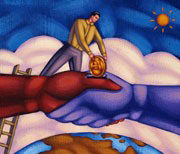Here’s a pop quiz. Read the following two paragraphs and see which is more apt to tug at your heartstrings:
A) Any money that you donate will go to Rokia, a seven-year-old girl who lives in Mali in Africa. Rokia is desperately poor and faces a threat of severe hunger, even starvation. Her life will be changed for the better as a result of your financial gift. With your support, and the support of other caring sponsors, Save the Children will work with Rokia’s family and other members of the community to help feed and educate her, and provide her with basic medical care.
B) Food shortages in Malawi are affecting more than three million children. In Zambia, severe rainfall deficits have resulted in a 42% drop in maize production from 2000. As a result, an estimated three million Zambians face hunger. Four million Angolans — one-third of the population — have been forced to flee their homes. More than 11 million people in Ethiopia need immediate food assistance.
How to Get Donations: The Emotional Appeal
If you answered A, you are like most people, according to a new study conducted by Deborah Small, a Wharton marketing professor, and two colleagues. The researchers found that if organizations want to raise money for a charitable cause, it is far better to appeal to the heart than to the head. Put another way, feelings, not analytical thinking, drive donations.
Identifiable Victims: A Key Strategy in How to Get Donations
Rokia is what academic researchers call an “identifiable victim.” As such, her personal story, which focuses exclusively on her plight and not that of other famine victims, is much more likely to generate charitable donations than more dispassionate descriptions of unnamed “statistical victims” like those in paragraph B, according to Small.
Why Emotional Stories Help in How to Get Donations
That people would want to give money to identifiable victims like Rokia rather than unnamed famine victims may not seem all that surprising. But Small and her colleagues, in a series of field experiments, delved deeper into the issue of sympathy and how it relates to charitable giving. The researchers found that if people are presented with a personal case of an identifiable victim along with statistical data about similar victims caught up in a larger pattern of illness, hunger or neglect, overall donations actually decline. In addition, they found that if people are told about the inconsistent levels of sympathy evoked by identifiable and statistical victims — the “identifiable victim effect,” in the words of the researchers — people reduce their giving to identifiable victims but do not increase their giving to statistical victims.
The Identifiable Victim Effect in Getting Donations
Small says the findings — which hold implications for policymakers, fundraisers for charities and even news organizations that urge donations to victims of tragic events — show that sympathy and aid-giving are often irrational.
“When donating to charitable causes, people do not value lives consistently,” write Small and her co-authors, George Loewenstein of Carnegie Mellon University and Paul Slovic of Decision Research, a non-profit research firm in Eugene, Ore. “Money is often concentrated on a single victim even though more people would be helped if resources were dispersed or spent protecting future victims.”
In many cases, society “would be better off if resources were spread among victims such that each additional dollar is spent where it will do the most good,” according to the paper, titled “Sympathy and Callousness: The Impact of Deliberative Thought on Donations to Identifiable and Statistical Victims.” Yet when making a decision to donate money toward a cause, “most people probably do not calculate the expected benefit of their donation. Rather, choices are made intuitively, based on spontaneous affective reactions.”
Real-Life Examples of How to Get Donations
The study cites several well-known examples of large sums of money being donated to help identifiable victims. In 1987, a child named Jessica McClure, dubbed “Baby Jessica” by the news media, fell into a well near her home in Texas and received nearly $700,000 in donations from the public. Ali Abbas, a boy who lost both his arms and his parents in the Iraq War in 2003, was the subject of widespread media attention in Europe and received some $550,000 in donations. Even animals generate sympathy: In 2002, more than $48,000 was contributed to save Forgea, a dog stranded on a ship adrift in the Pacific Ocean.
Psychological Insights on How to Get Donations
Why do identifiable victims elicit such an outpouring of emotion — as well as piles of accompanying cash? In general, psychological research has found that “people pay greater attention and have stronger emotional reactions to vivid rather than pallid information,” says Small, a psychologist by training. Furthermore, the mind responds to proportions, not absolute values. “This is why we gasp when we see a 50%-off sale, regardless of whether the original price is $5 or $500,” she adds. “Similarly, saving 10 lives out of a group of 100 is a high proportion and thus evokes a greater emotional response than saving 10 lives out of one million. An identifiable victim is the extreme, in this sense. When a victim has been identified, she becomes her own frame of reference — there was only one Baby Jessica to save — and thus receives the greatest level of sympathy.”
Field Experiments on How to Get Donations
Small and her co-authors reached their conclusions by conducting a series of four field experiments involving ordinary citizens. The researchers gave each person $5 in one-dollar bills. They were then instructed to read a letter containing a charity request and asked to donate a sum of money, ranging from zero to $5, by placing the money anonymously in an envelope.
Balancing Rational Thinking and Emotional Appeals in Getting Donations
Each experiment was designed to encourage “rational” thinking when people made decisions about how much money to donate to identifiable and statistical victims. In one experiment, for example, the subjects were told about the identifiable victim effect before being asked to make a donation. In another experiment, the researchers provided statistics about victims alongside a request for donations to an identifiable victim.
The Impact of Statistical Information on Getting Donations
The upshot of the four experiments was that people are most generous when asked to make a donation to an identifiable victim in the absence of “rational” analytic thought. The more statistical information the citizens were given about the general plight of a group of people, the less generous they became. Yet emotion-based thought failed to augment generosity to statistical victims. “It’s easy to override people’s feelings by giving them statistical information,” according to Small. “But it’s not so easy to add feelings where feelings aren’t naturally there to begin with. It’s hard for humans to generate feelings toward statistics.”
Insights on Improving Strategies for How to Get Donations
One subtle positive finding was that informing ordinary citizens about the identifiable victim effect at least had the result of increasing their consistency towards the two types of victims. Yet the field experiments showed that giving people statistical information had a pernicious effect on overall caring, since people gave less to the identifiable victims but no more to the statistical victims.
Challenges in Raising Donations: The Callousness Effect
“Insight, in this situation, seems to breed callousness,” the researchers write. “In some ways, this conclusion seems well founded. Faced with almost any disaster of any magnitude, it is almost always possible to think of worse things that have happened or even that are currently happening in the world. The deaths of 9/11 [numbering 2,973], for example, compared with the slaughter in Rwanda [estimated at between 500,000 and one million]” seem to have less impact. But the slaughter in Rwanda, in turn, “is dwarfed by the problem of AIDS in Africa. Thinking about problems analytically can easily suppress sympathy for smaller-scale disasters without, our research suggests, producing much of an increase in caring for larger-scale disasters.”
The Potential for Rational Thinking to Increase Donations
Yet the researchers acknowledge that this interpretation may have limitations. It is possible, they say, that deliberate, rational thinking in some cases may lead to more charity. “For example,” they write, “contrary to the difference between statistical and identifiable victims, we often experience little visceral sympathy for needy victims who are from other countries or of a different race or socioeconomic status, but thinking about their plight may lead us to recognize their deservingness. In such instances, we conjecture, interventions that encourage deliberate thinking like those presented in the four studies … might lead to greater generosity rather than less.”
Creating a Compelling Message: The Key to Getting Donations
What implications does Small’s paper hold for charitable organizations? “It’s all about putting together a simple, emotionally compelling message,” Small says. “The best way to do that is in the form of a picture or a story, something that purely engages the emotional system. The mistake that many charities make is trying to appeal both to emotion and to reason. They assume this would be more effective than appealing to only one or the other, but it isn’t.”
Bottom Line: Emotional Appeals Can Help Get More Charitable Donations
Although they feel that charitable donations might be more efficiently distributed among more desperate victims if donors were not so emotional in making decisions to give money, the researchers do not criticize people who wish to help when they feel sympathetic.
“Although the money spent on Baby Jessica and Ali Abbas could save more lives in theory if not concentrated as such, the absence of identifiability effects might reduce the impetus to give at all,” they write. “Thus, although victim identification may distort aid allocation somewhat, its impact generates more aid than any other pitch. Charities certainly recognize this, at least implicitly, when they employ a poster child to raise money for a general cause.”



